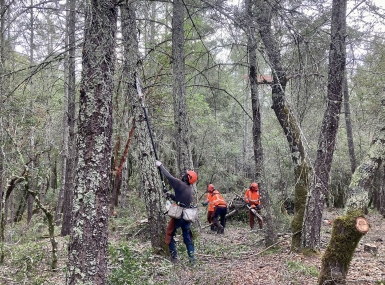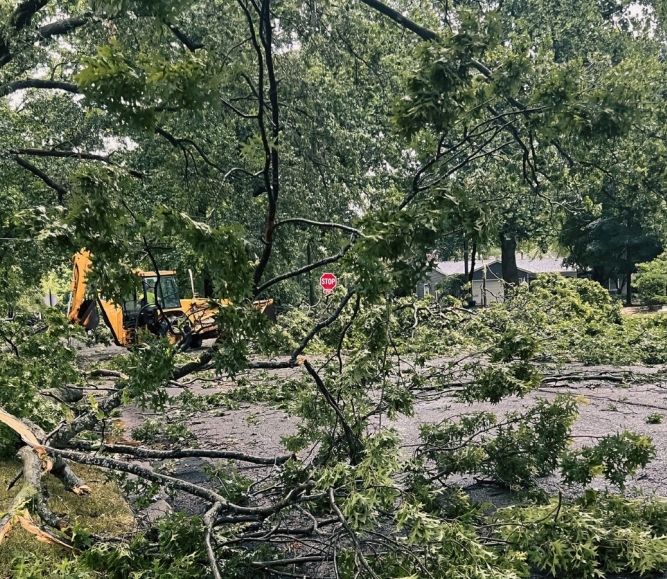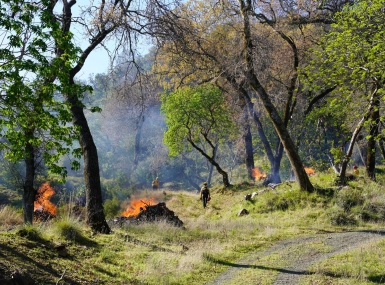Author

Meredith Moran
Upcoming Events
Related News

Key Takeaways
Disasters are becoming “more frequent, more severe and more costly,” and counties, parishes and boroughs are at the frontlines — where the immediate response is handled and where the personal impact is felt.
Federal funding can be difficult to navigate. While national organizations are working together to streamline the emergency management process, local and state officials need to prioritize mitigation, which can include building disaster resilience into other programing and creating pre-placed emergency contracts, according to speakers at a Feb. 9 NACo Intergovernmental Roundtable on Disaster Resilience held in partnership with The Pew Charitable Trusts.
Billion-dollar weather disasters have skyrocketed in the past 40 years from an average of 3.3 a year to 22, and communities across the country are increasingly dealing with wildfires, flooding, extreme heat and extreme winter storms, among other disasters.
With the high cost of disasters, state and local leaders work with federal agencies to get much-needed federal dollars to their hard-hit communities. But access to the funding can be difficult. While the disaster roundtable participants shot their hands up when asked how many of them have received federal funds for disaster relief, not a single hand was raised when asked if funding was easy to access.
Citing a 6 to 1 return on investment, counties need to focus instead on mitigation instead of recovery after disaster strikes, said Ashleigh Holland, director of the NACo Counties Futures Lab.
Using AI, FEMA is working with the Department of Agriculture to make disaster resiliency grants easier for local and state officials to navigate. By plugging in “I want to do XYZ in my community, what are the things I need to leverage?” counties will be provided with a list of opportunities, according to Victoria Salinas, acting deputy administrator for FEMA Resilience.
Federal hazard mitigation organizations are also increasing coordination so that they can move projects from one funding stream to another to maximize efficiency and the impact of their dollars, Salinas said.
She cited a Utah project involving seismic retrofit for water pipelines. FEMA ended up funding the project, but it could have also been supported through the Environmental Protection Agency, which devoted billions of dollars in grant funding for water infrastructure. “It wasn’t the best use of competitive grant dollars to actually fund something that was eligible under another program,” she noted.
“There’s not enough federal public dollars available for the amount of adaptation and risk reduction that we urgently need to get done,” Salinas said. “So, it’s not a federal solution, it’s a partnership solution.”
To stretch their dollars, county officials need to build disaster resilience into other programming — addressing it separately is limiting, said Dave Bowman, deputy director, Colorado Department of Local Affairs.
“If you’re building a road and a bridge, and you’re getting highway money or you’re getting FEMA [public assistance], you’ve got to be thinking about resilience at the same time,” Bowman said. “Those need to be infused and added on to every program, rather than trying to create separate funding streams.”
Numerous disasters have hit Jefferson Parish, La. in recent years, including tropical storms, tornadoes, saltwater intrusion and record heat. “The tragedies just kept building upon itself,” said Jefferson Parish President Cynthia Lee Sheng, who runs emergency management.
Handling back-to-back disasters has highlighted how essential it is to invest in mitigation, Lee Sheng said, and a “critical” element of that is creating pre-placed emergency contracts.
“OK, you did the rescue, but are you ready?” Lee Sheng said. “Do you have the place to bring them, do you have the backup place to bring them because that initial place might be flooded? When you bring them there, do you have the food and water ready to give them? Do you have the cots? Do you have wound care? I had recreation people caring for wounds.
“You might have to hold them for two or three days before the state can come help you over in buses … do you have a nonprofit or medical hookup to get them medicine? Do you have a place to take their pets? Can somebody in a wheelchair take a shower?”
When it comes to disaster recovery, extensive documentation is essential, Lee Sheng said: “You’ve got to tell the story.”
“Somebody in D.C. sitting in their office doesn’t know everything,” Lee Sheng said. “It takes resources to get resources, so it’s those resources and planning on the front end that’s the sweet sauce to getting reimbursement that next year and years later.”
Embedding a finance team into the recovery process is an underutilized way to do this, she added.
“People who have their first emergency, they tend to take that finance person in to get reimbursement after the fact because it seems like ‘Well, later on, we’ll get reimbursements,’” Lee Sheng said. “They need to see the tragedy, they need to see the people who we’re trying to help, they need to live it with me. That gives them the passion to say, ‘I’ve got to get this money back, so that my community gets whole again,’ … You need them fighting the fight with you.”
Vulnerable people feel the effects of disaster first, and it’s the people who are the most vulnerable and underserved who often won’t advocate for themselves, so it’s essential for local leaders to do so, Lee Sheng said.
Effectiveness in disaster resilience comes down to reducing preventable human suffering, Salinas said. So, to create the most benefit, FEMA has changed its criteria to encourage projects that address multiple types of hazards and threats.
“It’s a layered cake, and it’s not just one agency’s responsibility as well, it’s not one community’s responsibility or one level of government’s responsibility,” Salinas said. “But effectiveness is pretty clear: Was this preventable human suffering? Did we do everything we could do to reduce it?
“So that’s really what we’re aiming at, is working with partners and looking at all of those levers … we’re all affected equally by a disaster, but we haven’t actually achieved equitable resilience.”
Related News

County Countdown – April 21, 2025
Every other week, NACo's County Countdown reviews top federal policy advocacy items with an eye towards counties and the intergovernmental partnership. This week features the ARPA reporting deadline, a budget reconciliation update and more

FEMA halts disaster mitigation grant program
On April 4, the Federal Emergency Management Agency (FEMA) announced it will not allocate $750 million this year for the Building Resilient Infrastructure and Communities (BRIC) grant program. According to the press release, FEMA will also stop funding BRIC projects that were previously approved and are still underway.
County News
County News Spotlight - Disaster Mitigation
September is National Preparedness Month, and County News looked at issues, resources and opportunities for counties to be ready.

